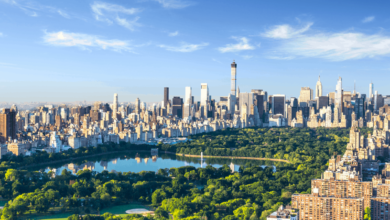The City Under the City – Subterranean Network Underneath NYC
Millions of humans (and 600,000 dogs) walk the streets of New York every day, unaware of the massive underground network beneath their feet. This hidden infrastructure carries the city’s electricity, water, internet, sewage, steam and natural gas. Each element of the network is managed – and often owned – by a different municipal agency or private company. There is no single map of all these interconnected systems. And yet, repairs that require the streets to be opened are carried out an average of 550 times a day, a potentially dangerous situation if workers lack data on what lies beneath.
The city is currently working on a comprehensive underground infrastructure map using the Geographic information system (GIS), a computer system used to organize information about locations on the earth’s surface. New York City already has a base layer map, and various agencies and companies can create data layers based on this map. A similar map for surface infrastructure can be explored here, and the city’s Open Data Labs have also created a detailed street mapbut the version of the underground infrastructure will probably never be public for security reasons.
Although we can’t know exactly what lies below us at any given location in the city, we can explore New York’s underground city from the deepest layer down to concrete and asphalt just by under the sole of our shoes.
bedrock
Deep beneath NYC is bedrock, the solid rock beneath the ground and the sand that extends inward toward the earth’s core. Between a billion and 300 million years ago, tectonic plates collided and volcanic ridges erupted, near what would become New York City, forming many of the distinctive rock formations and ridges of Manhattan and the Bronx. In many areas, this bedrock is visible or very close to the surfacewhich is important because modern skyscrapers are anchored to bedrock, and digging deep to find bedrock is difficult and expensive.
Between 90,000 and 70,000 years ago, the Wisconsin Glacier extended south over the city and, as it retreated, it left a terminal moraine, a belt of rocks, silt, and debris, above the city, but particularly across Brooklyn and Queens. Indeed, the boroughs of Long Island would be underwater without the sediment left by the glacier, because their bedrock is below sea level.
While all of this may give you flashbacks to high school earth science, it’s important for engineers to know and follow the construction and maintenance of the city’s underworld. Information on soil types and water levels is planned for the final underground infrastructure map.
Water tunnels and the water system
The deepest man-made element of the vast infrastructure beneath the city are the water tunnels, which transport the 981 million gallons of water New York uses every day from the city’s 2,000 square mile watershed. The tunnels, the first of which was completed in 1917, the second in 1936 and the third nearing completion in 2022, cut through bedrock between 1,110 feet and 520 feet below sea level. The force of gravity moves the water through the tunnels, and the pressure of the constant flow creates sufficient upward pressure to send the water down the conduits, 200 feet below the surface, and thence into the vertical shafts up to 35 feet in diameter which supply water. water mains, iron and steel up to 7 feet in diameter that supply water to service lines that serve individual homes and businesses. These are buried at a depth of only about three feet. The city has nearly 7,000 miles of water mains, and they run under almost every street.
Sewer pipes
About 100 feet below the streets of New York City are 7,000 feet of sewer lines. There are two types of water in New York’s sewers: sewage, which is anything that is flushed down the drain or flushed down the toilet, and stormwater, which is say rain and snowmelt. About 60 percent of the city’s sewers are combined sewer systems, which means pipes carry both stormwater and sewage directly to one of 95 sewage treatment plants. The appearance and structure of sewer pipes are not uniform throughout the system. In 2011, Luis Baerga, a longtime sewer inspector, said The New York Times, “It depends on how it was built. Some of them were built elliptical. Some look like pipes. Some of them are square. I remember one time… it looked like a catacomb.
The Subway
The New York City Subway includes approximately 450 miles of electrified underground tracks and 275 fully underground stations, as well as 2,000 turnouts. The deepest station, 180 feet below ground level, is the 191st Street stop on the 1 train, although many are much closer to the surface. The subway’s proximity to sewers and water lines makes it vulnerable to breakage, which can cause flooding and disrupt rail service while the repair is in progress.
Gas lines
There are 6,302 miles of natural gas pipes underground in New York City, usually buried at a depth of less than thirty feet. Natural gas comes into the city via interstate pipelines. It then passes through one of six “city gates” or meter stations, from where it is routed through 400,000 service pipes to a power station or “zone gas regulating station”, where the pressure is reduced for delivery to homes and businesses. About 65% of the city’s heating and cooking is powered by natural gas, as is 98% of the electricity produced by the city’s power plants.
Steam pipes
New York City is home to the world’s largest and oldest steam system, which dates back to 1882. Today, many buildings in Manhattan are heated or cooled by steam, and steam is also used to produce hot water. Hospitals use steam for disinfection and museums use it to regulate humidity. There are 105 miles of underground steam lines from the city’s steam generating plant in the Financial District to 96th Street on the Upper West Side and 89th Street on the Upper East Side. The pipes are found at depths between 10 and 30 feet below street level.
Cable/Fiber
New York City’s Internet, old-fashioned telephone, and cable television reach homes and businesses via a network of more than 50,000 miles of cabling just below the surface of New York’s streets and sidewalks. York. Much of this cable, whether fiber, coaxial, or lead-clad copper telephone cables, runs through disused conduits or pipes left in place.
Power
86% of New York’s electricity is distributed via the underground grid. Approximately 130,000 miles of power lines run beneath the city, connecting the 16 lines that import power from out of town to 24 transmission substations, 50 area substations, and then to residences and businesses . Occupying the same sub-street strata as cable and fiber, electricity is close to the surface.
So the next time you and your pup go out for a walk, take a minute to pause and imagine everything below you, from near the surface to deep in the rock: power lines, cables and fibers, steam pipes, gas pipes, underground. , sewer lines, water pipes, water tunnels, and all sedimentary rocks and soil deposited by the retreating glacier. The next time you turn on the stove, plug in your phone or take a shower, know that each of these resources – natural gas, electricity and water – arrives in your apartment through a vast and complex system that makes the city both that it is and extends beyond the borders of the city, making our daily conveniences dependent on distant places.




